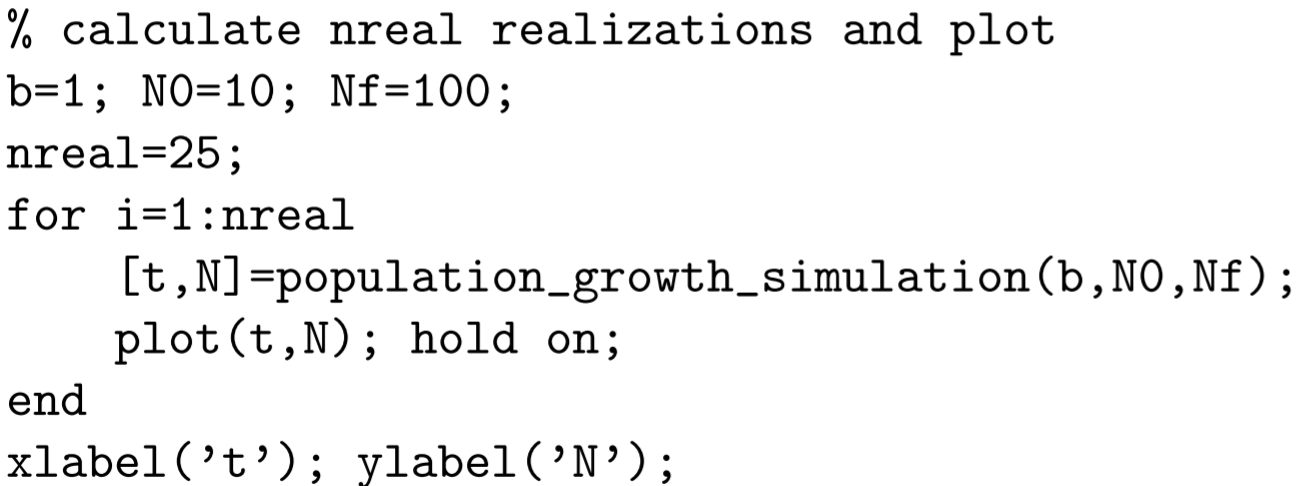3.3: Simulation of Population Growth
- Page ID
- 93504
As we have seen, stochastic modeling is significantly more complicated than deterministic modeling. As the modeling becomes more sophisticated, a numerical simulation becomes necessary. Here, for illustration, we show how to simulate individual realizations of population growth.
A naive approach would make use of the birth rate \(b\) directly. During the short time interval \(\Delta t\), each individual has probability \(b \Delta t\) of giving birth. We can decide if an individual gives birth by generating a random deviate (a pseudo-random number between zero and one): if the random deviate is less than \(b \Delta t\), then the individual gives birth; if larger than \(b \Delta t\), then the individual does not. With \(N\) individuals at time \(t\), we then simply compute \(N\) random deviates. Counting the number of random deviates less than \(b \Delta t\) allows us to update the population size to the time \(t+\Delta t\). For accuracy, \(\Delta t\) must be small, making this a computationally slow method.
There is, however, a much more efficient way to simulate population growth. Define a random variable \(\tau=\tau(N)\) to be the time it takes for a population to grow from size \(N\) to size \(N+1\) because of a single birth. The random variable \(\tau\) is called the interevent time and represents the elapsed time between births. A simulation from population size \(N_{0}\) to size \(N_{f}\) would then simply require computing \(N_{f}-N_{0}\) different random values of \(\tau\), a relatively easy and quick computation if we know the probability density function (pdf) of \(\tau\).
Accordingly, we define \(P(\tau)\) to be the pdf of \(\tau\) for a population of size \(N\). The cumulative distribution function (cdf), \(F(\tau)\), defined as the probability that the interevent time is less that \(\tau\) is given by
\[F(\tau)=\int_{0}^{\tau} P(\tau) d \tau \nonumber \]
where \(P(\tau)=F^{\prime}(\tau)\). The complementary cumulative distribution function (ccdf), \(G(\tau)\), defined as the probability that the interevent time is greater than \(\tau\) is given by \(G(\tau)=1-F(\tau)\)
Now the probability that the interevent time is greater than \(\tau+\Delta \tau\), with \(\Delta \tau\) small, is given by the probability that it is greater than \(\tau\) times the probability that there are no births in the time interval \(\Delta \tau\). Therefore, \(G(\tau+\Delta \tau)\) satisfies
\[G(\tau+\Delta \tau)=G(\tau)(1-b N \Delta \tau) \nonumber \]
Differencing \(G\) and taking the limit \(\Delta \tau \rightarrow 0\) yields the differential equation
\[\frac{d G}{d \tau}=-b N G \nonumber \]
which can be integrated using the initial condition \(G(0)=1\) to obtain
\[G(\tau)=e^{-b N \tau} \nonumber \]
From \(G(\tau)\), we can find
\[F(\tau)=1-e^{-b N \tau}, \quad P(\tau)=b N e^{-b N \tau} \nonumber \]
The pdf, \(P(\tau)\), has the form of an exponential distribution with parameter \(b N\).
Here, we make use of a well-known result from probability theory that enables us to compute \(\tau\) using random deviates. With \(y\) a random deviate, \(\tau\) can be computed from \(\tau=F^{-1}(y)\), where \(F^{-1}\) is the inverse function of \(F .\) The correct formula for the exponential distribution is
\[\tau=-\frac{\ln (1-y)}{b N} \nonumber \]
To simulate a population growing from \(N_{0}\) to \(N_{f}\), we compute \(N_{f}-N_{0}\) random deviates \(y\), and then compute the corresponding interevent times using \((3.3.6)\), taking care to adjust the population size \(N\) as the population grows.
Below, we illustrate a simple MATLAB function that simulates one realization of population growth from initial size \(N_{0}\) to final size \(N_{f}\), with birth rate \(b\).

The function population_growth_simulation.m can be driven by a MATLAB script to compute realizations of population growth. For instance, the following script computes 25 realizations for a population growth from 10 to 100 with \(b=1\) and plots all the realizations:




